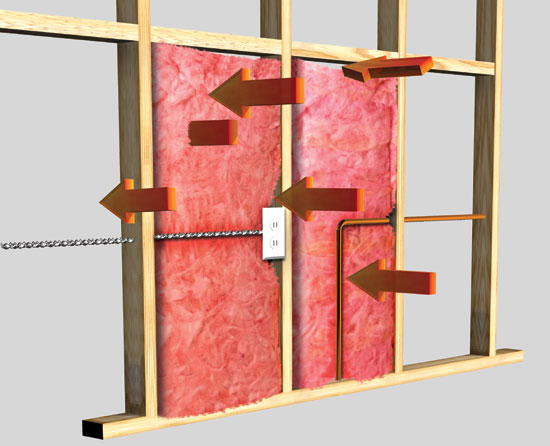Continuous Insulation Systems for Exterior Walls
Spray Foam Insulation Design Considerations
Regardless of the choice of the type of spray foam insulation being used, there are several general considerations to take into account when deciding how best to incorporate it into a building design including the following:
Fire Resistance and NFPA Testing of Assemblies
Building codes address foam insulation directly and typically require that it is covered or separated from the interior of the building by a 15-minute thermal barrier such as gypsum board or other approved material. When used in an exterior wall assembly, the concern becomes the control or prevention of fire within the wall assembly itself or between floors within that assembly. To receive appropriate fire code approvals, the entire assembly needs to be tested and evaluated, not just the component materials. Hence for a project being built according to the International Building Code an exterior wall assembly with spray foam insulation typically requires testing in accordance with ASTM E119 (timed fire resistance rating of assemblies) or NFPA 285 (evaluation of combustible components in a non-combustible assembly) standards in order to meet the safety and fire code demands of most jurisdictions. At a minimum, compliance with NFPA 285 is needed for most wall assemblies. Note that the details of NFPA 285- and ASTM E119-compliant wall assemblies vary according to the spray foam manufacturer and extra fireproofing attention may be necessary for some designs, particularly when detailing openings around windows and doors.
Environmental Considerations
Spray foam insulations require blowing agents to work and some of those agents are better for the environment than others. Materials used as blowing agents can be rated based on their Global Warming Potential (GWP) by comparing it to other materials. The most basic greenhouse gas is carbon dioxide with a GWP rating of 1. Hence, a spray foam insulation that is specified which uses only water and carbon dioxide as the blowing agents will similarly have a GWP rating of 1. Currently, there are several low-density spray foams with this very low environmental impact rating and at least one medium-density spray foam product has it as well. By contrast, all rigid foam insulation and most medium-density closed cell spray foam insulation need to rely on other blowing agents beside water and carbon dioxide to produce the desired results. Depending on the blowing agent used, the GWP rating can be very high up to around 1,430 due to its hydro-fluorocarbon (HFC) make-up. That means that the insulation has a greenhouse gas within it that is 1,430 times more potent than carbon dioxide. Of course there is only an environmental impact if it actually gets released from the insulation and into the air, which may not happen during installation. Nonetheless, if using closed cell spray foam insulation, it becomes important to seek out and specify a product with the lowest possible HFC content and the lowest possible GWP.
 |
Traditional fibrous batt insulation is prone to incomplete filling of the stud space cavities, allowing greater heat transfer than desired. Image courtesy of ICYNENE, Inc. |
Construction Considerations
The nature of any field-applied building product is such that the quality and the effectiveness of the final installation are directly dependent on the experience and qualifications of the installer. Variable field conditions such as air temperature and the condition of the substrates being sprayed upon can directly impact the final results. An installer that understands and adjusts to those field conditions can make all the difference between an excellent installation and one that could be compromised. Further, the nature of spraying the insulation is such that there will likely be some overspray or airborne spray that needs to be contained. Properly protecting the surrounding surfaces and coordinating with the work of other trades to be sure that mishaps are avoided can be very important aspects to the installation. With all of this in mind, it is worth a little investigation ahead of time to be sure that the spray foam insulation being specified has qualified and reputable installers are available to do the work in the building location.
With a basic understanding of the attributes, characteristics, and product variables of spray foam insulation, let's turn our attention to its critical function—energy performance.









